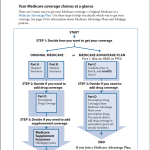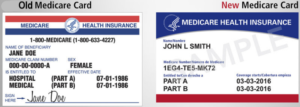Get Started With Medicare
1. Sign up for Medicare through Social Security
2. Choose your coverage
Medicare is our country’s health insurance program for people age 65 or older.(1a) If you’re a U.S. citizen or you meet the lawful presence and residency requirements, the Initial Enrollment Period (IEP) is your first chance to sign up for Medicare. It starts 3 months before your 65th birthday, includes the month you turn 65, and ends 3 months after the month you turn 65.(2) The program helps with the cost of health care, but it doesn’t cover all medical expenses or the cost of most long-term care. You have choices for how you get Medicare coverage. If you choose to have original Medicare coverage, you can buy a Medicare supplement policy (called Medigap) from a private insurance company to cover some of the costs that Medicare does not cover.(1a) For example for Part B services, Medicare generally pays 80% of the Medicare-approved amount, after you pay the Part B yearly deductible. You pay the remaining 20% coinsurance.(2)

Different Parts of Medicare:
• Medicare Part A (hospital insurance) helps pay for inpatient care in a hospital or skilled nursing facility (following a hospital stay). Part A also pays for some home health care, and hospice care.(1a)
Premiums $ Late Enrollment Penalty Deductible
• Medicare Part B (medical insurance) helps pay for services from doctors and other health care providers, outpatient care, home health care, durable medical equipment, and some preventive services.(1a)
Premiums $ Late Enrollment Penalty Deductible
• Medicare Part D (Medicare prescription drug coverage) helps cover the cost of prescription drugs.(1a)
Premiums $ Late Enrollment Penalty Deductible
Advantage Plans (also known as Medicare Part C or All-in-One-Plans) A replacement alternative plan to Original Medicare offered by private companies. There are very important difference you should fully understand before ever considering an Advantage Plan over Original Medicare.
Your Medicare Coverage Choices at a Glance (3a)
Rules For High-Income Beneficiaries
Working Past 65 & How does Medicare work with my employer based health Insurance.
Your Medicare Card
New Medicare cards were issued between April 2018 -April 2019 The new Medicare Beneficiary Identifier (MBI) replaced the SSN-based Health Insurance Claim Number (HICN) on the new Medicare cards for Medicare transactions like billing, eligibility status, and claim status. Starting January 1, 2020, claims must be submitted using MBIs (with a few exceptions), no matter what date the service was performed.
• Advantage Plans Medicare Part C (1a)
References:
(1) Social Security- Medicare Benefits: Social Security- Medicare Benefits
(1a) Social Security-Medicare Publication
(2) The Official U.S. Government Site for Medicare- Medicare.Gov
(2a) Medicare & You
(2b) Understanding Medicare Part C & D Enrollment Periods
(3) Centers for Medicare & Medicaid Services (CMS)
(3a) Choosing a Medigap Policy
(5) New Laws for Medicare Supplement Insurance ” Medigap” Department of Insurance- California

